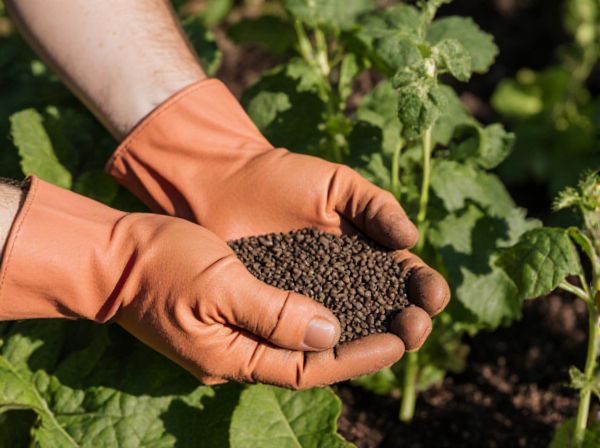
Pre-soaking Seeds vs Dry Sowing Illustration
Pre-soaking seeds accelerates germination by softening the seed coat, enabling quicker water absorption and enzyme activation. Dry sowing relies on natural soil moisture and temperature conditions, often resulting in slower and less uniform seedling emergence. Choosing between pre-soaking and dry sowing depends on seed type, environmental conditions, and desired germination speed.
Table of Comparison
| Aspect | Pre-soaking Seeds | Dry Sowing |
|---|---|---|
| Germination Speed | Faster; seeds absorb water, activating growth processes. | Slower; seeds rely on natural soil moisture. |
| Seed Viability | Improves seed viability by softening seed coat. | Depends on seed type and environmental conditions. |
| Risk of Rot | Higher risk if soaked too long or soil drainage is poor. | Lower risk; seeds dry until natural moisture triggers germination. |
| Ease of Planting | Seeds are softer and easier to plant. | Seeds remain hard; planting may require more effort. |
| Optimal Use | Best for hard-coated or slow-germinating seeds. | Suitable for seeds that germinate easily without pre-treatment. |
Introduction to Seed Germination Methods
Pre-soaking seeds involves immersing them in water before planting to accelerate the germination process by softening the seed coat and activating metabolic pathways. Dry sowing, on the other hand, entails planting seeds directly into the soil without pre-treatment, relying on natural moisture and soil conditions to trigger germination. Selecting between pre-soaking and dry sowing depends on seed type, soil environment, and desired germination speed, influencing overall plant establishment and growth success.
What is Pre-soaking Seeds?
Pre-soaking seeds involves immersing them in water for a specific period to accelerate germination by softening the seed coat and activating the embryo. This technique enhances moisture absorption, leading to faster and more uniform sprouting compared to dry sowing, where seeds are directly planted without prior hydration. Pre-soaking is especially beneficial for hard-coated seeds or those with long germination periods, improving overall seedling vigor and establishment success.
Understanding Dry Sowing Techniques
Dry sowing involves planting seeds directly into the soil without prior soaking, relying on natural moisture to trigger germination. This technique is especially useful for seeds that require stratification or are sensitive to excess moisture, reducing the risk of rot and fungal infections. Understanding soil conditions, temperature, and moisture levels is critical to successful dry sowing and promoting optimal seedling development.
Benefits of Pre-soaking Seeds
Pre-soaking seeds accelerates germination by softening the seed coat and enhancing water absorption, leading to quicker and more uniform sprout development compared to dry sowing. This process reduces the risk of seed desiccation and improves seedling vigor, resulting in higher germination rates and stronger early growth. Pre-soaking is especially beneficial for hard-coated or larger seeds, ensuring optimal moisture uptake and boosting overall crop establishment success.
Advantages of Dry Sowing
Dry sowing seeds simplifies the planting process by eliminating the need for pre-soaking, reducing labor and time requirements for gardeners. This method promotes natural seed dormancy cycles, which can enhance germination rates for certain species adapted to direct soil contact. Furthermore, dry sowing minimizes the risk of fungal infections often associated with overly moist conditions during pre-soaking.
Ideal Seeds for Pre-soaking
Seeds with hard coats such as beans, peas, and corn benefit significantly from pre-soaking, which speeds up water absorption and promotes faster germination. Pre-soaking is ideal for large, drought-resistant seeds that naturally require moisture softening to break dormancy. In contrast, small or fine seeds like lettuce or carrots are generally better suited for dry sowing to avoid rotting.
Best Seeds for Dry Sowing
Best seeds for dry sowing typically include hardy varieties such as lettuce, carrots, and spinach, which can tolerate planting directly into soil without pre-soaking. Dry sowing enables seeds to absorb natural moisture gradually, which promotes stronger root development and reduces the risk of seed rot common in overly wet conditions. Selecting seeds with thicker coats or those adapted to local climate conditions enhances germination success and supports robust seedling growth.
Step-by-Step Guide to Pre-soaking Seeds
Pre-soaking seeds involves immersing them in water for 12 to 24 hours to soften the seed coat and accelerate germination, particularly for hard-coated seeds like beans and peas. After soaking, seeds should be drained and planted in a moist, well-draining medium at the recommended depth for the specific plant species. This method increases germination rates by ensuring seeds absorb adequate moisture before sowing, reducing the time needed for sprouting compared to dry sowing.
How to Successfully Dry Sow Seeds
Dry sowing seeds involves planting them directly into the soil without pre-soaking, requiring well-prepared, loose, and moist soil to promote optimal seed-to-soil contact and moisture absorption. To successfully dry sow, evenly distribute seeds at the recommended depth and cover lightly with soil to prevent crusting, ensuring consistent moisture through regular watering. Monitoring soil temperature and moisture levels is crucial, as it encourages natural germination processes and helps avoid seed rot or poor emergence.
Choosing the Right Method for Your Garden
Pre-soaking seeds accelerates germination by softening seed coats and promoting faster moisture absorption, ideal for fast-growing plants or short growing seasons. Dry sowing suits hardier seeds or larger gardens where natural rainfall can trigger germination without extra prep. Selecting the right method depends on seed type, climate, and garden conditions to maximize sprouting success and plant health.
Pre-soaking Seeds vs Dry Sowing Infographic

 gardendif.com
gardendif.com